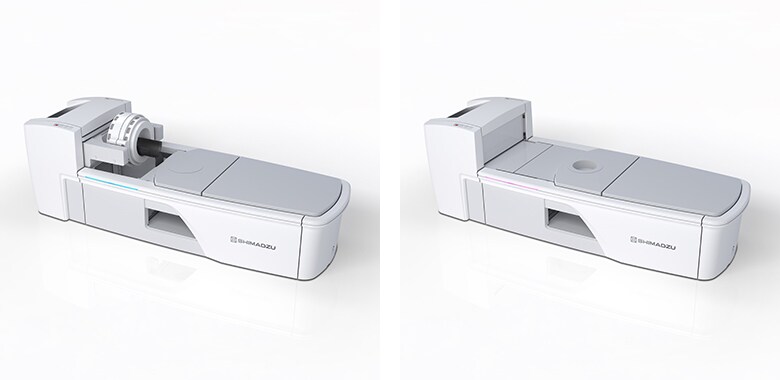March 1, 2021 | News & Notices
Release of World’s First TOF-PET System Specialized for Head and Breast Examinations
Scanning Brain Tumors, Epilepsy and Breast Cancers with Outstanding Accuracy and Even Supporting Alzheimer’s and Other Dementia Researches

BresTome TOF-PET System
Head scan mode
Breast scan mode
On March 1, 2021 Kyoto Japan, Shimadzu Corporation released the new BresTome TOF-PET functional imaging system dedicated for head and breast within Japanese domestic market. It offers double resolution of common whole body PET systems. In addition to clinical applications*1 for brain tumors and epilepsy covered by Japanese public health insurance, it can be used to support clinical treatment of Alzheimer’s disease (referred to below as “AD,” which is not yet covered by Japanese insurance) and various degenerative neurological disorders. It also contributes to brain researches intended to delay the onset and progression of diseases by discovering symptoms at an early stage.
It can switch the detector configuration from head position to breast mode just by pressing a button. Using Shimadzu’s experience gained from our sales of Elmammo Avant Class dedicated breast PET systems used by breast surgery departments, the BresTome system offers even greater supports in clinical use.
*1: Using the BresTome system alone should be limited to cases where using it in combination with a whole body PET system is clearly not necessary.
PET (Positron Emission Tomography)
Positron emission tomography is a method used for imaging various types of cancer by administering an agent containing glucose labeled with the radioisotope fluorine-18, based on the fact that cancer cells metabolize many times more glucose than normal cells. Recently, amyloid PET is increasingly being used to measure as well as cerebrospinal fluid examinations and visualize the quantity of beta-amyloid plaques in the brain, considered a major cause of AD. TOF-PET is a PET system with the "Time of Flight" technology to provide higher definition images in shorter time.
Combination of Medical and Analytical Technologies
In December 2020, the Shimadzu Amyloid MS(Mass Spectrometry) CL system for measuring amyloid peptides in the blood (referred to below as “Amyloid MS CL system,” which is not released), which presents a biomarker* value related to beta-amyloid plaque levels from a blood test, received approval of Japanese Pharmaceuticals and Medical Devices Act as a “controlled medical device” (Class II device) based on rebalancing notice. In the future, Shimadzu aims to combine analytical and measuring technology for analyzing blood with medical systems technology for diagnostic PET imaging to establish methods for preventing various types of dementia and contribute to clinical diagnostic researches and drug discovery researches.
*Its clinical significance is not evaluated.
Features
1. Dramatically Improved Detection Performance for Brain Functions
The adjacent-type detector hole (30 cm diameter) features state-of-the-art semiconductor detectors. Compared to whole body PET systems (with a detector hole diameter of about 80 cm), the BresTome offers higher sensitivity and higher examination throughput for high-definition imaging of pharmacokinetics in the brain. For breast examinations, it provides high definition images equivalent to dedicated breast PET systems and can even obtain images close to the chest wall.
2. World’s First System to Integrate a Dedicated Head PET System and Dedicated Breast PET System
By moving the detector hole, it can be used for head and breast examinations. It is the first PET system in the world designed specifically for head and breast examinations by a single system.
Professor Kazunari Ishii of the Department of Radiology at Kindai University Faculty of Medicine, who has been involved in joint research for the prototype of this system, commented as follows.
“For being the world’s first practical dedicated head PET system, this system is able to provide very high resolution. Although the additional verifications of different device principles from conventional PET-CT are under way in joint research, it represents a revolutionary system that addresses the growing demand for brain PET examinations. As a dedicated breast PET system, it offers a broader imaging range than previous models, for even imaging axillary lymph nodes, which is expected to be especially beneficial in clinical use.”


